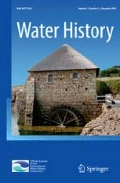The five papers in this issue of Water History present the dynamic interactions between humans and their surrounding landscapes when people attempt to manipulate nearby water sources or make more distant water sources available. Presented in chronological order, the first three papers offer case studies from three different times and places, whereas the last two contributions discuss aspects of Palestine/Israel’s water history.
In the first paper, Antonio Rotolo introduces the drainage galleries in the Iberian Peninsula from an archaeological point of view, with specific attention to the Islamic period. After presenting the theoretical issues that emerge when situating drainage galleries within their broader context, he examines the relation between types of galleries and their environment. Rotolo also discusses the role of the Romans in spreading the technology across the Iberian Peninsula.
Next, Ian Simmons brings us to late Roman times in what is now the east coast of England, where sea level rise created complex landscapes of tidal wetlands and freshwater fens. These ecosystems were colonized by Germanic and Danish immigrants and gradually drained. Using the example of a typical parish, Simmons attempts to assign dates to the phases now visible in the landscape. Although the location is now a dry environment, it has clearly been defined by its water history.
The third paper, by Michael Agar and Ellen Taylor, takes us forward in time and space to mid- to late-twentieth century New Mexico (USA). Using the city of Albuquerque’s efforts to control urban flooding as their primary case, they show how differences in worldview and governmental approaches influenced decisions about flood control in a specific place. The Albuquerque case, while unique in the confluence of events and actors that shaped the city’s response to floods, offers an example of the importance of water to urban politics.
The last two papers deal with the complex water history of Palestine/Israel. In the first, David Schorr surveys the water law of Palestine under British rule. It becomes clear that despite a lack of official power, Arabs and Jews succeeded in co-shaping water law in this period (1917–1948). Schorr uses a court case from Arab residents against government expropriation of water to illustrate this point. The British tried reforming water law to increase state control, but the opposition of Zionist groups to government regulation remained strong.
Finally, Eran Feitelson, Assaf Selzer and Ram Almog show how histories of water interventions are intertwined with landscape properties and change. The dramatic transformation of the Palestine/Israel landscape in the twentieth century involved large water abstractions and inter-basin transfers. Drawing upon three cases that represent the different stages of water system development from 1920 to 1970, the authors show how the history of settlement and water is connected.
Each of these papers underscores the complexity of the human-water relationship. Whether it was through the creation of drainage galleries and flood control projects or through the establishment of legal codes and policy, the importance of water to human life has led people to find creative ways to alter and control their hydrological environments.
Author information
Authors and Affiliations
Corresponding author
Rights and permissions
About this article
Cite this article
Ertsen, M.W., Hoag, H.J. Editorial 6.3. Water Hist 6, 189–190 (2014). https://doi.org/10.1007/s12685-014-0109-3
Published:
Issue Date:
DOI: https://doi.org/10.1007/s12685-014-0109-3

